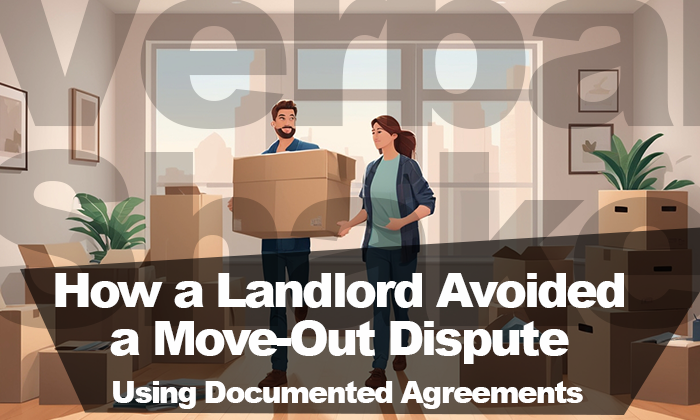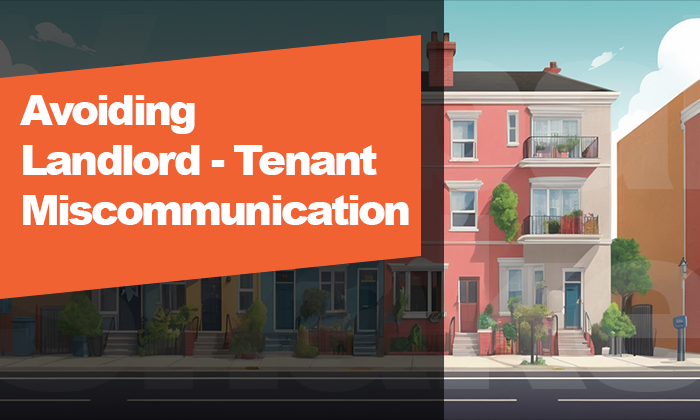How a Landlord Avoided a Move-Out Dispute Using Documented Agreements

Move-outs should be straightforward. A tenant hands in their keys, the landlord does a final inspection, and the security deposit is refunded (minus any deductions for damages).
But without clear expectations in writing, move-out day can quickly spiral into security deposit disputes, cleaning disagreements, and unexpected repair costs—just like it did for Sarah, a landlord who learned this lesson the hard way.
Here’s how Sarah’s experience highlights why documented move-out agreements are essential for landlords and tenants.
The Move-Out Dispute: “I Thought Spotless Meant…”
Sarah owned a single-family rental home and had been renting to Mike for two years. When Mike gave his 30-day move-out notice, he reassured her:
"Don’t worry, I’ll have the place spotless when I move out."
Sarah trusted him. He had been a good tenant—always paid rent on time and took decent care of the property. But when she did the final walkthrough, she found:
❌ Scuff marks on the walls
❌ Trash left in the garage
❌ A stained carpet in the living room
Sarah pointed these things out, but Mike pushed back:
"This is normal wear and tear. I should get my full security deposit back."
The problem? There was no written record of what “spotless” actually meant. Sarah assumed it meant professional-level cleaning; Mike assumed it meant a quick sweep and vacuum.
Since the lease only included a general move-out clause, it became a frustrating dispute over security deposit deductions.
Without clear written expectations, Sarah couldn’t prove her case, and Mike walked away upset—leaving her with unexpected cleaning costs.
How Sarah Prevented Another Move-Out Dispute
The next time a tenant was preparing to move out, Sarah decided to handle things differently.
She documented everything before the tenant left to ensure expectations were clear:
✔️ Move-Out Agreement: She sent the tenant a written checklist outlining the required move-out condition:
“Tenant agrees to return the unit in the same condition as move-in, excluding normal wear and tear. Walls must be free of marks, carpets professionally cleaned, and all trash removed.”
✔️ Tenant Confirmation: The tenant replied, “Got it, I agree.”
✔️ Smooth Move-Out: On move-out day, the tenant followed the agreement, completed the cleaning, and received the full security deposit—no disputes, no frustration.
Sarah’s small change—getting move-out agreements in writing—transformed a stressful situation into a smooth, professional transition.
Why Move-Out Agreements Prevent Disputes
? Verbal promises create confusion—written agreements create clarity.
? A quick written acknowledgment eliminates disagreements over security deposit refunds.
? Move-out expectations should always be documented to avoid costly misunderstandings.
A simple move-out agreement protects both landlords and tenants by setting clear expectations.
Without it, tenants might assume “clean” means tidy, while landlords expect deep cleaning and repairs.
How to Create a Move-Out Agreement That Prevents Disputes
If you want zero confusion on move-out day, use a clear, written agreement outlining expectations. Here’s how:
✅ 1. Create a Move-Out Checklist
Before move-out, send a checklist covering:
✔️ Required cleaning (e.g., vacuuming, dusting, deep-cleaning carpets)
✔️ Repair expectations (e.g., patching nail holes, repainting if needed)
✔️ Trash removal and key return instructions
✔️ Timeline for completing the move-out process
✅ 2. Get Written Confirmation from the Tenant
Have the tenant acknowledge the move-out terms in writing. A simple text or email confirmation works.
Example Message:
? “Just confirming that your move-out date is May 31, and per our agreement, the unit should be returned in the same condition as move-in, minus normal wear and tear. Please make sure walls are free of scuffs, carpets are cleaned, and all trash is removed. Let me know if you have any questions.”
Even a quick ‘Got it’ reply gives you written proof in case of a dispute later.
✅ 3. Use Tools Like Verbal Shake to Secure Agreements
We created Verbal Shake because we saw too many landlords and tenants getting caught in “I thought we agreed on…” disputes.
With Verbal Shake, landlords can:
✔️ Create clear move-out agreements in minutes—without drafting a formal contract.
✔️ Get tenant confirmation instantly—so there’s no debate later.
✔️ Store move-out agreements securely—so they can be referenced at any time.
Instead of relying on memory, landlords can document move-out expectations in real-time—avoiding unnecessary stress and security deposit conflicts.
FAQ: How to Avoid Move-Out Disputes as a Landlord
Q: What happens if a tenant refuses to clean before moving out?
A: If move-out expectations are in writing, you can legally deduct cleaning and repair costs from the security deposit. If nothing is documented, it becomes harder to enforce.
Q: Do tenants have to return a rental in perfect condition?
A: No, but they must return it in the same condition as when they moved in, minus normal wear and tear. A written move-out agreement helps clarify what’s expected.
Q: What qualifies as normal wear and tear?
A: Small nail holes, minor carpet wear, and faded paint are normal wear and tear. Large stains, broken fixtures, and excessive dirt are not.
Q: How do I make sure tenants follow my move-out requirements?
A: Put expectations in writing. Even a short message or a tool like Verbal Shake ensures both parties understand their responsibilities.
Final Thoughts: Protect Yourself from Move-Out Disputes
Move-out day doesn’t have to be stressful.
A simple, written agreement eliminates confusion, protects your security deposit deductions, and keeps tenant relationships professional.
✅ Before move-out, outline cleaning and repair expectations.
✅ Get the tenant’s written confirmation to prevent disputes.
✅ Use Verbal Shake to document and secure move-out agreements.
A few minutes of effort today can save you hours of frustration later.
Want to Avoid Move-Out Disputes?
Verbal Shake is launching soon! Be among the first to try it and ensure your agreements are always clear and enforceable.
Sign up for updates here below



